Study on Seismic Response and Vibration Reduction of Shield Tunnel Lining in Coastal Areas
Abstract
:1. Introduction
2. Theoretical Overview
2.1. Calculation of Damping Coefficient Applied to Seismic Wave
2.2. Nonlinear Model Foundation of Surrounding Rock and Soil Mass
3. Numerical Simulation
3.1. Model Establishment
3.2. Selection and Input of Seismic Wave
4. Analysis of Numerical Results
4.1. Static Analysis
4.2. Modal Analysis
4.3. Time History Analysis
4.3.1. Time History Analysis of the First Principal Stress Response
4.3.2. Time History Analysis of Displacement Response
4.3.3. Time History Analysis of Acceleration Response
5. Analysis of Damping Scheme
6. Conclusions
Author Contributions
Funding
Institutional Review Board Statement
Informed Consent Statement
Data Availability Statement
Acknowledgments
Conflicts of Interest
References
- Carol, S.P.; Daniel, J.P. Coseismic deformation of the Wrights tunnel during the 1906 San Francisco earthquake: A key to understanding 1906 fault slip and 1989 surface ruptures in the southern Santa Cruz Mountains, California. J. Geophys. Res. Solid Earth 1997, 102, 635–648. [Google Scholar]
- Pan, C.S. Overview of tunnel earthquake disaster. Tunn. Undergr. Eng. 1990, 11, 1–9. [Google Scholar]
- Yashiro, K.; Kojima, Y.; Shimizu, M. Historical Earthquake Damage to Tunnels in Japan and Case Studies of Railway Tunnels in the 2004 Niigataken-Chuetsu Earthquake. Q. Rep. RTRI 2007, 48, 136–141. [Google Scholar] [CrossRef] [Green Version]
- Gao, B.; Wang, Z.Z.; Yuan, S.; Shen, Y.S. Enlightenment from Wenchuan Earthquake on Road Tunnel Damage. J. Southwest Jiaotong Univ. 2009, 44, 336–341+374. [Google Scholar]
- Wang, Z.Z.; Jiang, Y.J.; Zhu, C.A.; Sun, T.C. Shaking table tests of tunnel linings in progressive states of damage. Tunn. Undergr. Space Technol. Inc. Trenchless Technol. Res. 2015, 50, 109–117. [Google Scholar] [CrossRef]
- Tang, L.Z.; Yu, L.; Wang, M.N.; Li, Z.X.; Zhang, X.; Lu, M.; Yang, H.H. Green’s functions based on the Timoshenko beam model for the longitudinal seismic dynamic response of tunnels crossing soft and hard rock strata. Tunn. Undergr. Space Technol. Inc. Trenchless Technol. Res. 2022, 128, 104545. [Google Scholar] [CrossRef]
- Mohamed, A.A.; Fathalla, M.E.; Ahmed, T.K. Mutual seismic interaction between tunnels and the surrounding granular soil. HBRC J. 2014, 10, 265–278. [Google Scholar]
- Zhao, X.; Li, R.H.; Yuan, Y.; Yu, H.T.; Zhao, M.; Huang, J.Q. Shaking table tests on fault-crossing tunnels and aseismic effect of grouting. Tunn. Undergr. Space Technol. Inc. Trenchless Technol. Res. 2022, 125, 104511. [Google Scholar] [CrossRef]
- Miao, Y.; Yao, E.; Ruan, B.; Zhuang, H.Y. Seismic response of shield tunnel subjected to spatially varying earthquake ground motions. Tunn. Undergr. Space Technol. Inc. Trenchless Technol. Res. 2018, 77, 216–226. [Google Scholar] [CrossRef]
- Cheng, X.S.; Xu, W.W.; Yue, C.Q.; Du, X.L.; Charles, H.D. Seismic response of fluid–structure interaction of undersea tunnel during bidirectional earthquake. Ocean Eng. 2014, 75, 64–70. [Google Scholar] [CrossRef]
- Zhang, G.L.; Wang, P.G.; Zhao, M.; Du, X.L.; Zhao, X. Seismic structure-water-sediment- rock interaction model and its application to immersed tunnel analysis under obliquely incident earthquake. Tunn. Undergr. Space Technol. 2021, 109, 103758. [Google Scholar] [CrossRef]
- Yao, E.; Sun, Q.N.; Li, W.C.; Yu, M.; Liu, M.S. Numerical study on the characteristics of the seismic response of subway shield tunnels beneath rock mountains: A case study in China. IOP Conf. Ser. Earth Environ. Sci. 2021, 861, 052067. [Google Scholar] [CrossRef]
- Quan, X.J.; Gao, J.H.; Wang, B.; Xu, J.H.; Zhang, Q.Z. Damage Mechanisms of Soft Rock Tunnels in the Western China: A Case Study on the Dujiashan Tunnel. Struct. Eng. Int. 2022, 32, 369–377. [Google Scholar] [CrossRef]
- Shen, Y.S.; Gao, B.; Yang, X.M.; Tao, S.J. Seismic damage mechanism and dynamic deformation characteristic analysis of mountain tunnel after Wenchuan earthquake. Eng. Geol. 2014, 180, 85–98. [Google Scholar] [CrossRef]
- Pai, L.F.; Wu, H.G. Experimental study on dynamic response of tunnel lining structure crossing landslide mass under earthquake. J. Rock Mech. Eng. 2022, 41, 979–994. [Google Scholar] [CrossRef]
- Liu, X.Y.; Zhang, C.Q.; Xiao, H.B.; Zhou, H.; Chi, F.D. Deformation and failure characteristics of a deeply buried tunnel subjected to creep slip fault movement: Based on the engineering conditions of Yunnan water intake project. Bull. Eng. Geol. Environ. 2022, 81, 322. [Google Scholar] [CrossRef]
- Jalayer, F.; Ebrahimian, H.; Miano, A.; Manfredi, G.; Sezen, H. Analytical fragility assessment using unscaled ground motion records. Earthq. Eng. Struct. Dyn. 2017, 46, 2639–2663. [Google Scholar] [CrossRef]
- Pan, J.C. Seismic Response Analysis and Seismic Isolation Research of Subway Shield Tunnel. Master’s Thesis, Anhui University of Technology, Hefei, China, 2019. Available online: https://kns.cnki.net/KCMS/detail/detail.aspx?dbname=CMFD202001&filename=1019093633.nh (accessed on 15 August 2022).
- Luo, B.S. Study on Deformation Law of Surrounding Rock in Construction of Shield Tunneling below Existing Line. Master’s Thesis, Dalian Jiaotong University, Dalian, China, 2018. Available online: https://kns.cnki.net/KCMS/detail/detail.aspx?dbname=CMFD201901&filename=1019019909.nh (accessed on 28 August 2022).
- GB 50011-2001; Code for Seismic Design of Buildings. 2001. Available online: https://max.book118.com/html/2020/0909/5321343214002342.shtm (accessed on 22 August 2022).
- GB 50111-2006; Code for Seismic Design of Railway Engineering. 2006. Available online: https://max.book118.com/html/2021/0219/8116064110003050.shtm (accessed on 24 August 2022).
- Wang, K.; Pan, H.; Zhang, T.; Wang, H.T. Experimental study on the radial vibration characteristics of a coal briquette in each stage of its life cycle under the action of CO2 gas explosion. Fuel 2022, 320, 123922. [Google Scholar] [CrossRef]
- Yue, C.Q. Seismic Response Analysis and Isolation Technology Research of Subsea Tunnel. Master’ Thesis, Lanzhou University of Technology, Lanzhou, China, 2013. Available online: https://kns.cnki.net/KCMS/detail/detail.aspx?dbname=CMFD201402&filename=1013251680.nh (accessed on 3 September 2022).


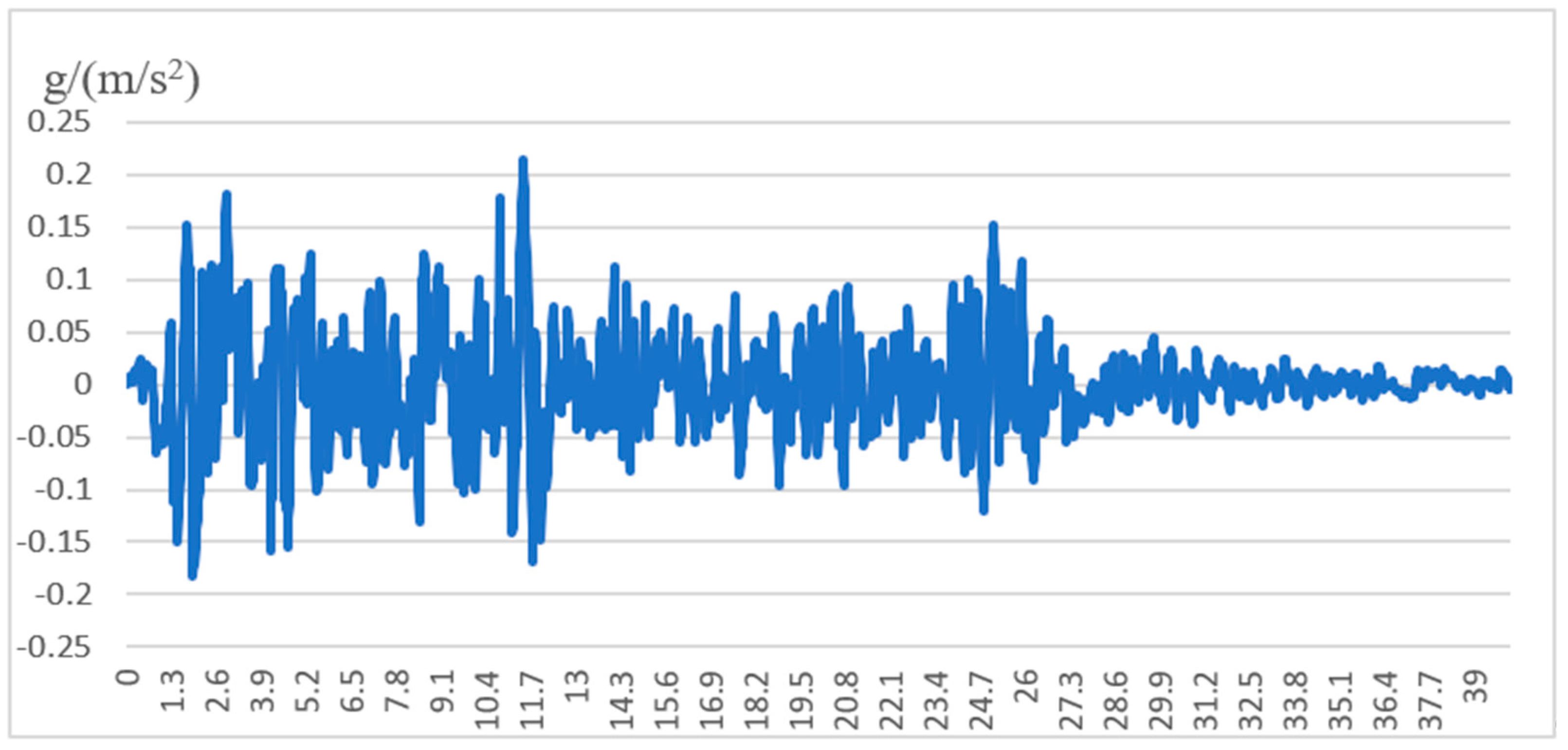
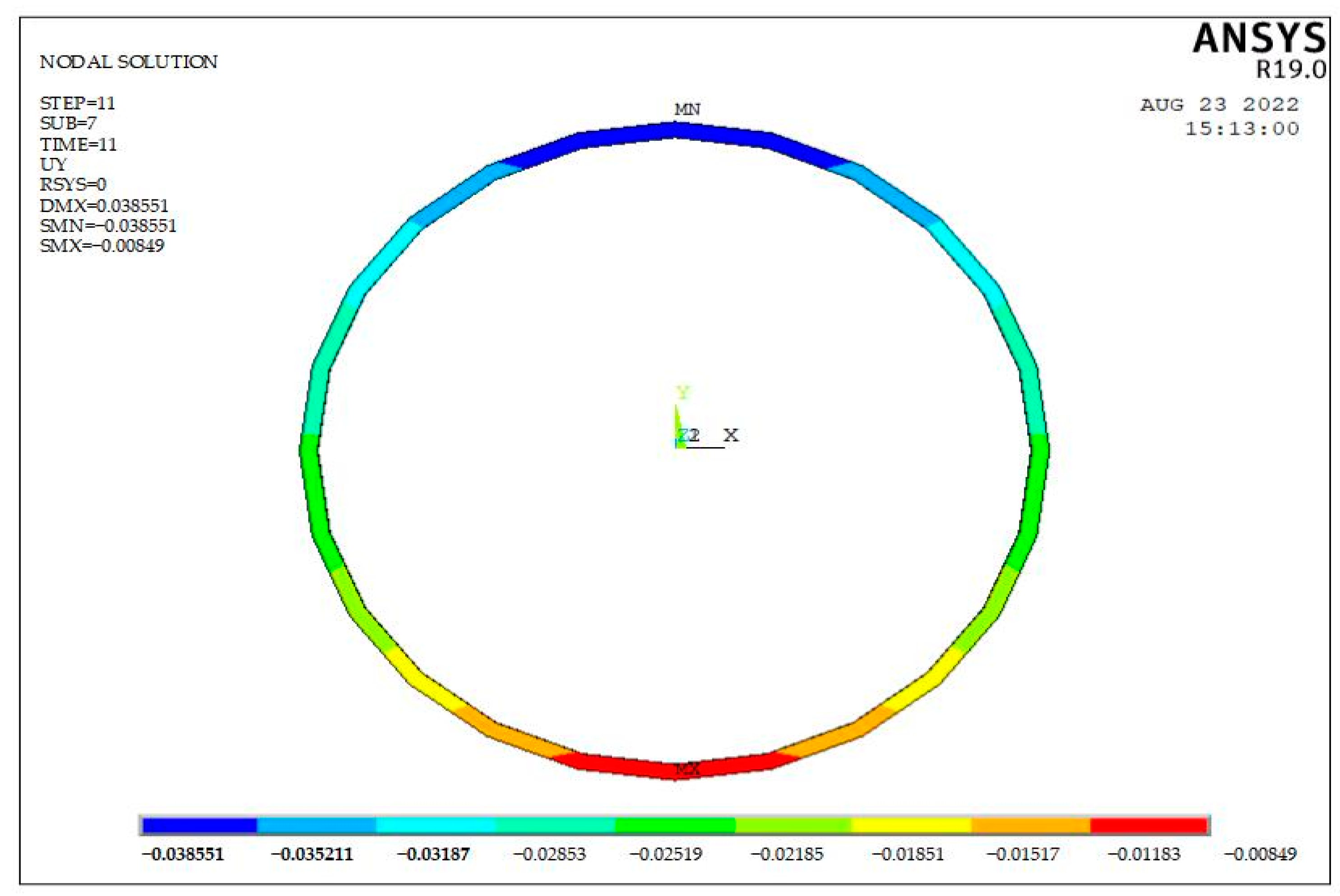
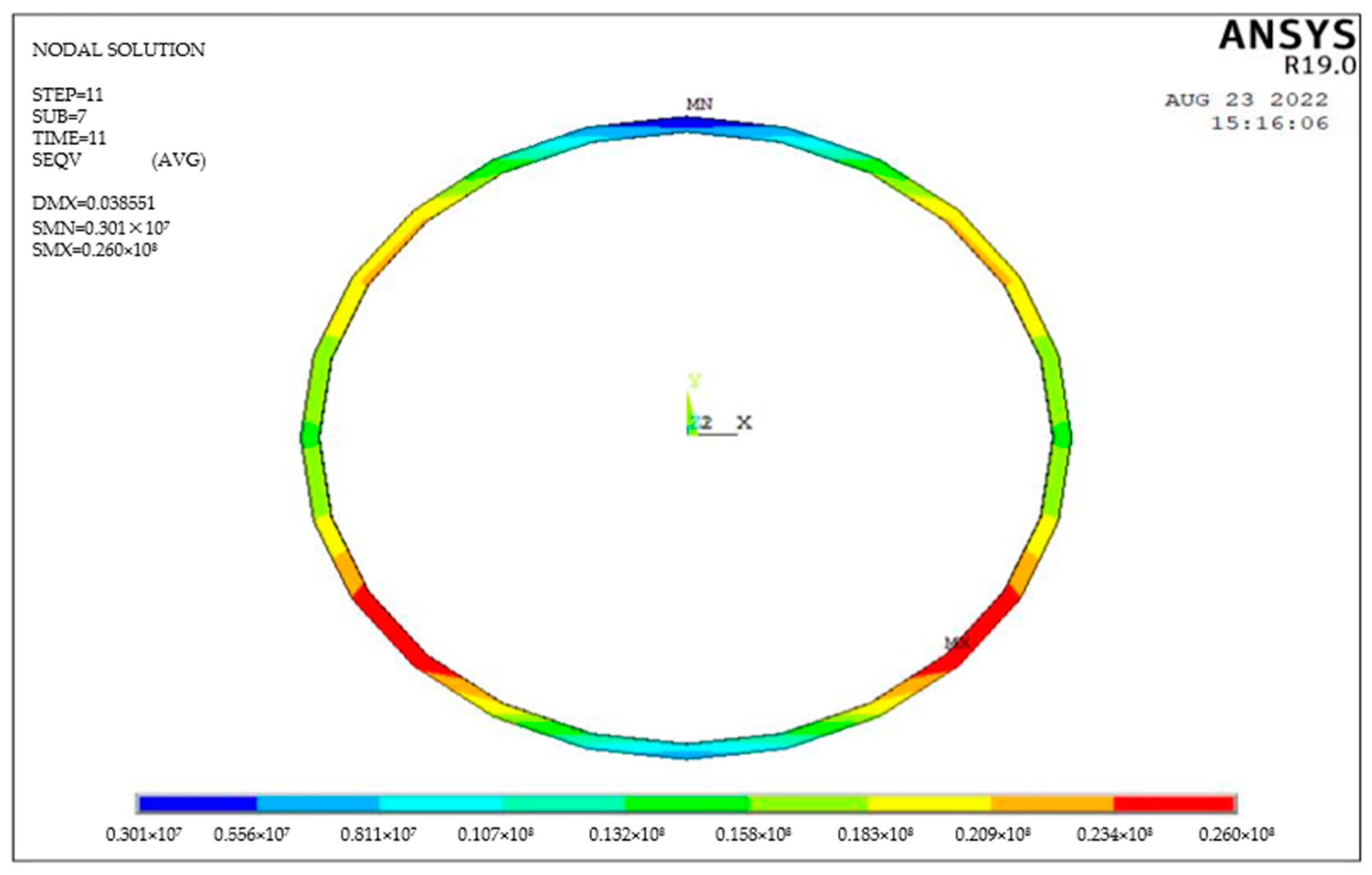

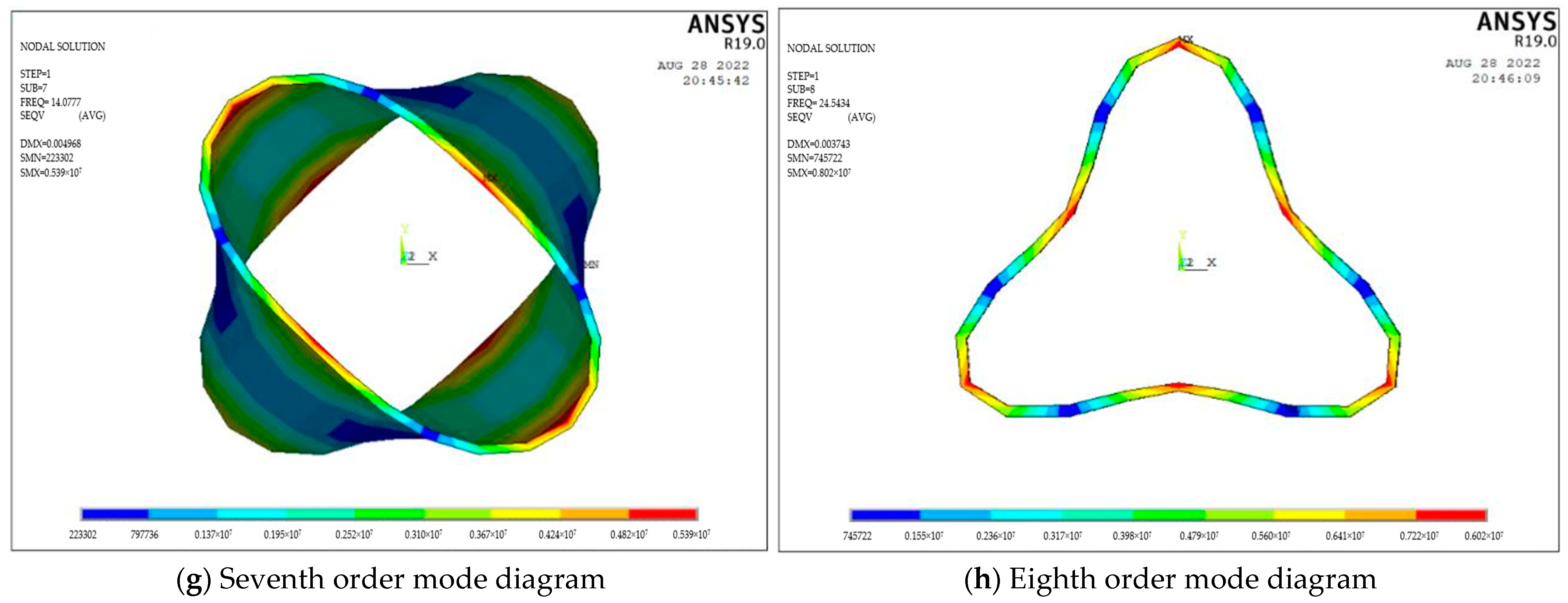
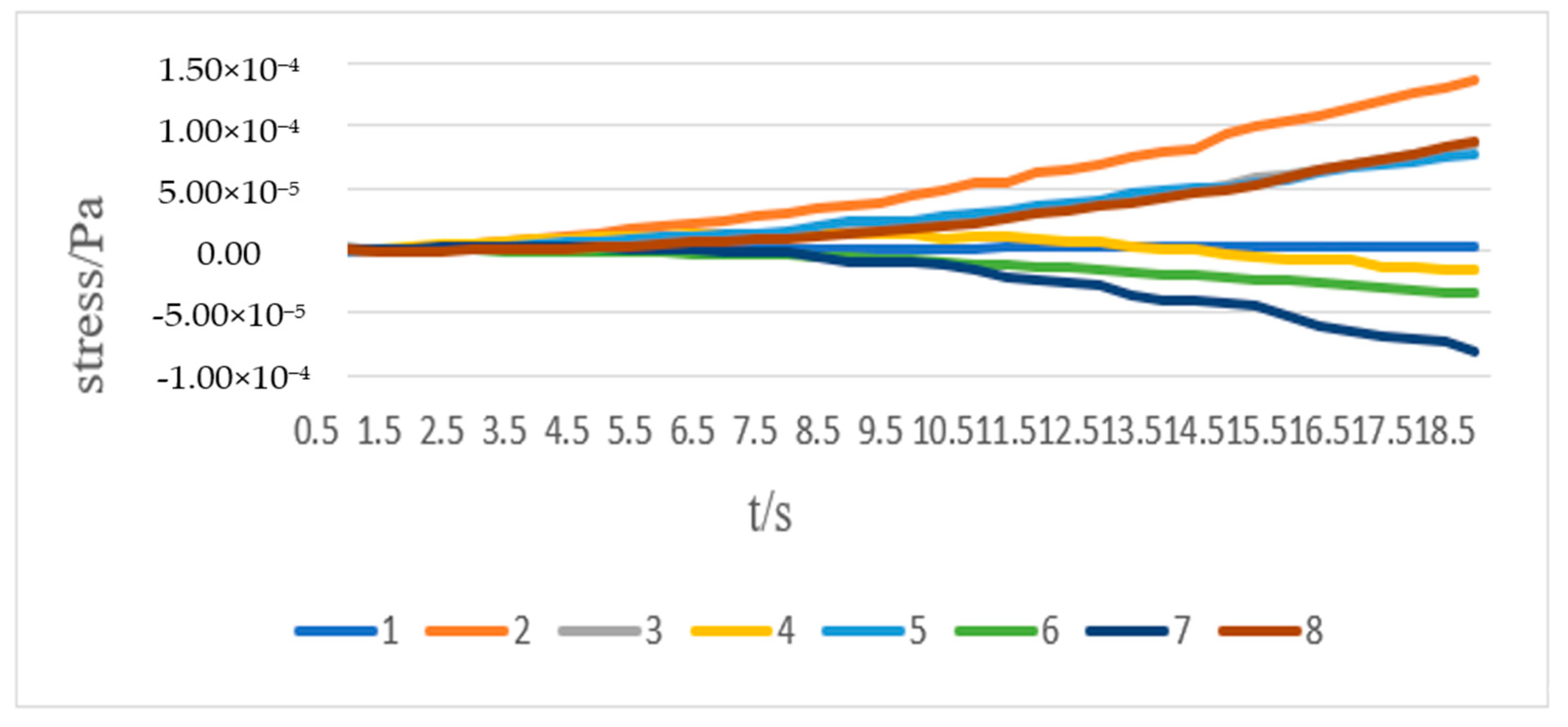


| Material Science | Elastic Modulus E (MPa) | Poisson’s Ratio μ | Cohesion C (kPa) | Internal Friction angle ψ (°) |
|---|---|---|---|---|
| Plain fill | 10 | 0.3 | 10 | 28 |
| Silty clay | 18 | 0.4 | 47 | 18.8 |
| Pebble soil | 90 | 0.2 | 3.8 | 38.5 |
| Slate | 300 | 0.28 | 300 | 30 |
| Name | Elastic Modulus E (GPa) | Poisson’s Ratio μ | Thickness (m) | Density (Kg/m3) |
|---|---|---|---|---|
| Lining | 34.5 | 0.3 | 0.3 | 2450 |
| Grouting layer | 0.2 | 0.25 | 0.15 | 2300 |
| Mode Shape | 1 | 2 | 3 |
|---|---|---|---|
| Frequency × 10−4 | 0.177 | 0.214 | 0.353 |
| Damping coefficient | Alpha = 0.015 Beta = 0.021 | Alpha = 0.015 Beta = 0.021 | Alpha = 0.015 Beta = 0.021 |
| Position | Vault | Right Arch Waist | Right Wall | Right Corner | Inverted Arch | Left Wall Corner | Left Wall | Left Arch Waist |
|---|---|---|---|---|---|---|---|---|
| Number | 1 | 2 | 3 | 4 | 5 | 6 | 7 | 8 |
| Minimum acceleration × 10−11 m/s | −8.097 | −5.397 | −4.652 | −6.234 | −8.091 | −5.896 | −3.515 | −5.230 |
| Maximum acceleration × 10−11 m/s | 7.486 | 4.051 | 2.785 | 5.276 | 6.525 | 5.309 | 3.164 | 4.548 |
| Material Science | Elastic Modulus E (MPa) | Poisson’s Ratio μ | Density (Kg/m3) | Cohesion C (kPa) | Internal Friction Angle Ψ (°) |
|---|---|---|---|---|---|
| Foam concrete | 270.0 | 0.21 | 557 | 50.0 | 15 |
| Rubber | 2.5 | 0.45 | 1000 | 0.6 | 6 |
| Position | Vault | Right Arch Waist | Right Wall | Right Corner | Inverted Arch | Left Wall Corner | Left Wall | Left Arch Waist | Reduction Rate of Right Arch Waist |
|---|---|---|---|---|---|---|---|---|---|
| Number | 1 | 2 | 3 | 4 | 5 | 6 | 7 | 8 | |
| Primary lining ×10−5 Pa | 3.455 | 13.733 | 8.450 | −2.029 | 7.848 | −3.414 | −8.528 | 8.995 | —— |
| Foam concrete ×10−5 Pa | 3.700 | 2.830 | −14.886 | 31.389 | 11.754 | 13.563 | 26.177 | −13.170 | 79.4% |
| Rubber ×10−5 Pa | 4.373 | 3.236 | −14.027 | 32.224 | 11.368 | 13.733 | 26.506 | −12.969 | 76.4% |
Disclaimer/Publisher’s Note: The statements, opinions and data contained in all publications are solely those of the individual author(s) and contributor(s) and not of MDPI and/or the editor(s). MDPI and/or the editor(s) disclaim responsibility for any injury to people or property resulting from any ideas, methods, instructions or products referred to in the content. |
© 2023 by the authors. Licensee MDPI, Basel, Switzerland. This article is an open access article distributed under the terms and conditions of the Creative Commons Attribution (CC BY) license (https://creativecommons.org/licenses/by/4.0/).
Share and Cite
Dong, S.; Zhang, X.; Jia, C.; Li, S.; Wang, K. Study on Seismic Response and Vibration Reduction of Shield Tunnel Lining in Coastal Areas. Sustainability 2023, 15, 4185. https://doi.org/10.3390/su15054185
Dong S, Zhang X, Jia C, Li S, Wang K. Study on Seismic Response and Vibration Reduction of Shield Tunnel Lining in Coastal Areas. Sustainability. 2023; 15(5):4185. https://doi.org/10.3390/su15054185
Chicago/Turabian StyleDong, Sihui, Xinyu Zhang, Chenxu Jia, Shiqun Li, and Kang Wang. 2023. "Study on Seismic Response and Vibration Reduction of Shield Tunnel Lining in Coastal Areas" Sustainability 15, no. 5: 4185. https://doi.org/10.3390/su15054185






